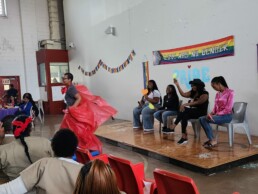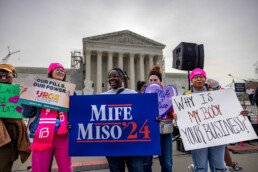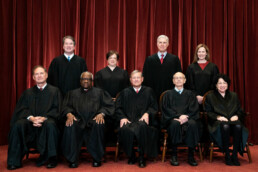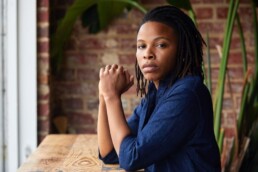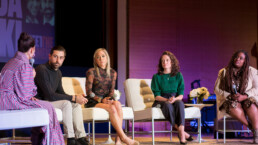Chrissy Teigen on Her Abortion
 June 20, 2024 Evening, Meteor readers, All morning, I was stressed about something trivial. But at noon, I read the following headline: A nearby black hole just woke up and devoured a whole galaxy. So that puts things in perspective! Also, RIP to galaxy SDSS1335+0728… we hardly knew ye. Back on planet Earth, we paid a visit to Washington, D.C. for a conversation between Chrissy Teigen and Vice President Kamala Harris about abortion access two years post-Dobbs. Plus, your weekend reading list. Waiting for the asteroid, Shannon Melero  WHAT'S GOING ON CHRISSY TEIGEN, VICE PRESIDENT KAMALA HARRIS, AND THEIR EXCELLENT CHEEKBONES IN CONVERSATION (SCREENSHOT VIA THE WHITE HOUSE) The Meteor’s SOL spent this afternoon at the White House listening to a conversation between Vice President Kamala Harris and Chrissy Teigen. (John Legend and all four of the pair’s children were in attendance; Wren, their youngest, had turned a year old on Juneteenth.) The event was timed to the anniversary, coming up Monday‚ of the Supreme Court’s decision to overturn Roe v. Wade. The impact of that decision, VP Harris said, “is not just that it offends some intellectual or conceptual or academic notion. The harm, the actual harm that has occurred to real people, every day since that decision came down is immeasurable.” Teigen became an advocate after seeing that harm. Today, she spoke about her own experience having an abortion due to complications from a pregnancy in 2020, and a more recent experience touring Feminist Women’s Health Center, an abortion clinic in Atlanta. (Some of its doctors were also in attendance at the White House.) Here, three of the most moving things Teigen shared:
Teigen went on to point out that there are risks to all Americans—not just those in states with abortion bans. “We’ve seen calls for a national abortion ban [and] a push to restrict access to contraception and IVF.” You can watch more of SOL’s day—and the conversation with the Vice President—on our Instagram stories. AND:
CAMERON BRINK COMING OFF THE COURT AFTER HER KNEE INJURY. (VIA GETTY IMAGES)
 WEEKEND READING 📚On preserving history: Nestled in a corner of an ever-changing Brooklyn sits Toñita's, the last Puerto Rican social club in the borough. (HellGate) On queer liberation: An intimate look behind the scenes of the world’s first Arab and anti-Orientalist drag festival. (Atmos) On getting into the 'ton: The regency romance show “Bridgerton” has created a space for characters of color in a story that could have easily been entirely white. But one Latina writer asks, “Why can’t it include us?” (Remezcla)  FOLLOW THE METEOR Thank you for reading The Meteor! Got this from a friend?
|
![]()
Voguing for Trans Liberation at New York's Most Brutal Jail
Jordyn Jay takes us inside Rikers Island for a ball
By Mik Bean
New York’s Rikers Island is one of the nation’s most notorious jails, where incarcerated trans people are treated especially inhumanely. But last Thursday, it was also the site of the second annual vogue ball for trans incarcerees. “We wanted to give our incarcerated siblings more opportunities to show their dedication to the culture and the art form that is ballroom,” says Jordyn Jay, founder of Black Trans Femmes in the Arts (BTFA), which organized the ball and has funded and supported Black trans femme artists for five years now. “We are there to celebrate them and to bring them joy in this very dark, cruel system of mass incarceration.”
I spoke with Jay about the Rikers ball and other radical acts of hope.
Mik Bean: Shows like Pose and Legendary and Beyoncé’s RENAISSANCE tour have brought ballroom culture to a wider audience. But its history is one of radical celebration in the face of violent criminalization. Why was it important to bring ballroom back to Rikers?
Jordyn Jay: So I want to be clear that the idea [for the ball] came from the folks detained and incarcerated at Rikers Island, and that is in line with the history of ballroom. Vogue began in Rikers Island from folks who were incarcerated there, referencing images that they saw in magazines. That was the only connection they had—not only to the outside world, but to their femininity, through expressing themselves by mimicking the models’ lines and shapes.
Modern ballroom culture as we know it was started [in the 1970s] by Crystal LaBeija, as a Black trans woman’s dream for what society could be. She created an ecosystem in which trans beauty and bodies were celebrated. We are grateful to the people who’ve taken ballroom to a global stage, but there are also consequences when you open up a safe and sacred place to the world. A lot of the femme queens—which is how we refer to trans women in the ballroom scene—have noticed that there’s been [little] appreciation for us as individuals despite the fact that we are, historically and currently, what people come to see.
So many ballroom legends and icons have passed through Rikers Island because of the criminalization of trans bodies and what trans people have to do to survive. It’s especially amazing that we’re able to bring formerly incarcerated trans women to work with currently incarcerated trans women and celebrate ballroom culture in this space during Pride—and to do so with an abolitionist lens.
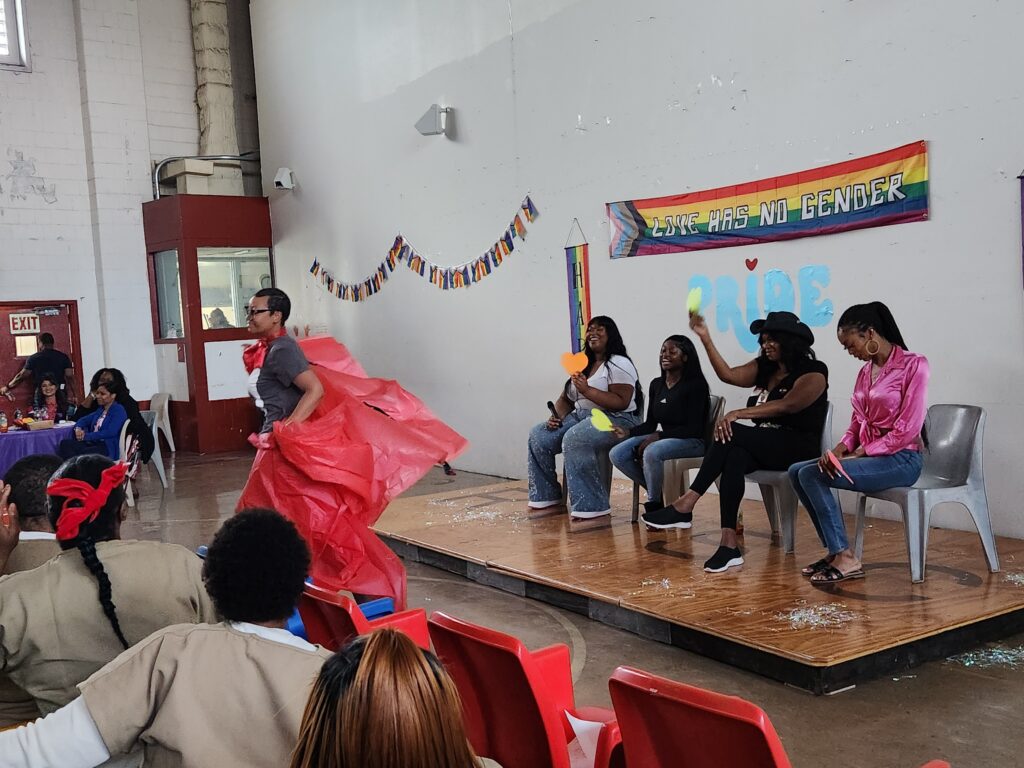
Can you explain what you mean by an “abolitionist lens”?
It’s so important that this ball is happening during Pride Month because pride and carcerality have a linked history. There would be no Pride Month without police brutality—without mass incarceration.
Rikers is a global symbol of the oppression of America’s mass incarceration and policing systems. So when we bring the arts and bring pride into that space, it is in itself a protest. We are hoping that by bringing the arts into Rikers…that this revolutionary, transformative energy of the arts is able to carry [incarcerated people] forward.
Can you describe the feeling of being at the Rikers ball?
I’d be remiss if I didn’t mention the darkness that we feel as we travel onto the island, as we navigate security, as we walk down the halls and folks are forced to stop and put their heads against the wall and their hands behind their back. It is a stomach-sinking feeling. But once we enter that room and see the faces of the folks who we came to support, there is so much empathy and so much joy.
It almost feels wrong to say that our visit to Rikers was fab, but truly, that’s the best way I can describe it. I think we came in with the intention of bringing joy and excitement to the women who were detained. We got just as much excitement as I hope that we gave them. The energy—the femme queen energy in particular—was just so palpable in the room. There was so much joy from the moment that we walked in.

Being trans is itself an act of creation. Can you share more about how you see that link in your own work?
So many of the organizing bodies that center around Black trans folks are geared towards houselessness, HIV/AIDS, and fighting [anti-trans] legislation. These things are really crucial, but [they] aren’t focused around joy. It’s a lot of talk of loss and trauma, and that really took a toll on me in the early days of my transition.
So I wanted there to be a space where we could not only come together and center joy, but also express ourselves through the arts and have the resources to do that. [Through grantmaking and production support, BTFA fosters the careers of artists like Kiyan Williams, recently celebrated for their work in the Whitney Biennial.] There are so many of us that have never had someone to sit down and touch our hand and say: “You can do this. I believe in you. I want to see your art in the world. I want to hear your voice in the world.”
Trans people have to create ourselves in a world that tells us that we shouldn’t exist, and that is the ultimate artistic expression. We’ve already broken this gender binary and this understanding of how people are able to exist in the world, so there’s really an endless flow of possibility. As I was moving through my transness and meeting new trans people, every one of them was an artist in their own way. When people engage with art created by Black trans femmes, it allows them to understand us as human beings—and to see themselves in trans people.
What is the future you envision for Black trans femmes artists?
BTFA’s vision statement is that we envision a world where Black trans femmes can create without limitations. The headline is always “Black trans femme artists,” and I think that’s wonderful for representation’s sake. But my question is: At what point do we as artistic scholars challenge ourselves to view this art as art and critique it as such? When we start to engage with the actual work, there’s so many more important conversations that can be had.
It’s just a pleasure to be able to watch this program expand. It’s in line with all that being a femme queen is: We break barriers down and we disrupt systems. Our form of protest in this space is joy, is laughter, is cheering. We hope that they all felt the power and energy behind this too-brief but very beautiful moment that we got to share.
Updated 6/19/2024: A previous version of this story incorrectly referred to Rikers Island as a prison. Rikers is a jail facility, however, the island where it is located is a "prison island." We have amended our language and regret the error.
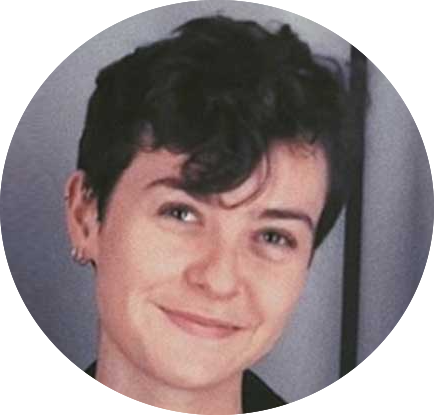 Mik Beanis a social media strategist with a master’s degree in journalism. A former advisor and content producer for organizations including The Washington Post, Instagram, and AIDS Healthcare Foundation, Mik specializes in political science and gender theory.
Mik Beanis a social media strategist with a master’s degree in journalism. A former advisor and content producer for organizations including The Washington Post, Instagram, and AIDS Healthcare Foundation, Mik specializes in political science and gender theory.
Have We Been Thinking About Ambition All Wrong?
Samhita Mukhopadhyay charts a new alternative for work life (beyond the girlboss or tradwife)
BY CINDI LEIVE
Samhita Mukhopadhyay has spent her career doing two things brilliantly: being a serious boss (she helped run the newsroom at Mic and served as the executive editor for Teen Vogue), and being a serious feminist (she was a founding editor at the late-'00s site Feministing). Those dual experiences—sometimes, but not always aligned—make her the perfect person to answer the question: What does, and what should, the future look like for women in the workplace? And can you be a boss and a feminist at the same time?
Those aren’t simple questions; work, after all, is a place with its own needs, bottom line, and occasional drudgery. (There’s that old expression: If work were that pleasant, the rich would keep it for themselves.) I’ve written and talked about the subject of women and work plenty, and I still don’t have answers.
But Samhita’s new book, The Myth of Making It: A Workplace Reckoning, does. Full disclosure, Samhita is a friend and colleague: We both worked at the media company Condé Nast, although we didn’t know each other there; now, we work together at the ever-so-slightly-less-glossy outlet you’re reading right now. (We think of it as The Devil Wears Sweatpants.)
She began writing this book during the pandemic, which was—you might remember?—a stressful time for working women. We started there.
Cindi Leive: When you started to write this book, there was a lot of gleeful dancing on the grave of the girlboss. Sheryl Sandberg’s Lean In, which had been a bible of early ’10s feminism, suddenly seemed very outdated—women were realizing that if you’re underpaid, overworked, and don’t have child care, no amount of leaning in was going to fix that. But you also didn’t want to chuck the whole idea of ambition. What was the problem you were trying to solve?
Samhita Mukhopadhyay: Woman after woman in my life who were extremely ambitious in their careers were starting to question that ambition because they weren't living the life that they thought they were going to live. They weren't finding the happiness or the meaning or the purpose, and they were struggling in their personal lives.
But it felt very easy [for society] to say, “Women's ambition is dead. We should have never let you have that education and have that career. Because look what it's done to you now. You're burned out; you're tired; you're a bad mother.”
It felt like there was no space for us to be like, I'm actually in between all of these narratives. Like, I'm not going to become a tradwife, but the way we’ve been taught about ambition—pull yourself up by your bootstraps, work as hard as possible, girlboss your way to the top—that narrative is also not working for me. I'm going to do something more impactful. And I wanted to explore that.
You just referred to the kind of other side of the spectrum from the girlboss—the tradwife. Can you define that term?
There has been a trend of [female] influencers declaring that they are no longer going to pursue career ambitions and they're more focused on their family and their husbands. It's a trend that's hard to actually quantify—it gets a lot of press coverage because anything that's critical of women's ambition gets a lot of press coverage. All the women in my life have to work! But I think we are fascinated with the idea of putting women back in their place.
That's where this question of limited narratives comes in, because wanting a soft life or embracing more balance in your life should not come at the cost of women's progress. A happy life with dignity should not come at the cost of you being able to pay your bills, right? We should be able to do all of that.
But work has become so inhumane, and we conflate a rejection of capitalist hustle culture with rejecting the progress of feminism. The problem isn't that women are ambitious and they want to work. The problem is that we have a society and workplaces that can't support [those ambitions]. Especially for mothers.

One of my favorite lines in the book is when you say that girlboss culture sold the idea that capitalism and feminism could have a totally functional baby. Do you see those things as totally at odds? Is there no place in feminism for trailblazers like Ursula Burns [the former CEO of Xerox] or Indra Nooyi [of Pepsi]—or even what you were doing at Teen Vogue?
I think the connection is not as…fluid as we had hoped. [laughs] Ursula Burns and Indra Nooyi, while they are groundbreaking, they are exceptions, right? They're often peddled to us as “You could do this, too!” And the reality is, most of us actually can't do that. It's impossible for one person to fix [the system]. It's collective action that's going to bring change. It's not necessarily that having women in these roles isn't valuable. I just don't think it's been as successful as it’s been sold to us.
You say that you don't have all the answers—you write that “this is not a how-to book.” But I’m going to push you for a little advice anyway. What’s the best way to be a better—and maybe more feminist—boss? You’re really good at it.
One of the things that I always think about is: What does it look like to have my ambition be connected to the ambitions of the people that work for me? So that I am a unit with them, and that no matter how I move forward in the workplace, my moving forward is connected to their moving forward. The research is showing that women are actually better at doing that, too: They're better at creating inclusive work environments where people feel seen. So what does it look like to shift the focus and say I will do everything I can to support my employees? Within reason, I mean; at the end of the day, we all have to get our jobs done. In some environments, profit’s gonna matter, productivity is going to matter. But I do think that as managers we can say to our employees, I will always advocate for the biggest raise for you. I will always advocate for you to get the training that you want. And for you to be able to take care of your family and to take care of yourself.
You also say that bosses need to be better about admitting mistakes. You tell a really vivid story in the book about being called the wrong name in a past role…
I was sitting in a high-level meeting and the person leading the meeting called me by the wrong name—the name of another South Asian executive at the company. It was a complicated moment: Technically, I wasn't supposed to be in that meeting; I was there in lieu of my boss. The other executive was supposed to be in the meeting, and she was not there, so it was the perfect storm for a mix-up. In the moment I was like, that couldn't possibly have just happened. But the person next to me was like, “No, that happened.”
The way you write about it, it sounds as if it was upsetting to be called the wrong name. But equally upsetting was the way it was handled, where nobody actually admitted to having done what they had done.
I did feel upset that it had happened. I already felt so uncomfortable in that room around all of these senior people. And that kind of confirmed for me that I really shouldn't be there. But—let people make mistakes, right? I use the wrong pronouns sometimes; things like that happen. I don’t think that it means that the person [making the mistake] is vicious or angry or inherently racist.
But everybody made a big deal about it, and I noticed that the focus was much more on this mistake rather than all of the forces that create a mistake like that: lack of representation for women of color in leadership roles, or lack of effective diversity and inclusion programs that actually address unconscious bias. There’s research on this: They call it the same-race effect or same-race bias; when you have not been exposed to a variety of people in another race, you tend to confuse them for each other. There's also a power dynamic here: People in management positions tend to do it more often than employees, because employees have to be very aware of the identity of the people that are managing them. And most managers are predominantly white, so you can see how that plays out. It was the conflation of all of those things in that moment. But we focus so much on the question of, “Oh, is that person racist or not racist?” And then that becomes the question, rather than how we create a situation where people of color can work with dignity.
So if someone does make a mistake like that, what is a better way of trying to deal with it?
First and foremost, by acknowledging the mistake and saying, “I am so sorry. I'm so embarrassed. Of course I know who you are. My mistake.” If you realize in the moment, do it in the moment. I’ve had to do that: “I’m sorry, I know that's not your gender pronoun, let me do that again.” It's a little awkward, but it goes a long way toward making the person feel seen and heard. And if you don't realize in the moment, admit that it happened and that you are committing to do better next time. I don't think people realize how far those apologies actually go! I really felt like I did something wrong, like, Oh my God, how dare I be here, and be Indian! So an apology helps.
There is this huge opportunity right now for leaders to really take seriously the question of how to make everybody feel included or confident or empowered at work. If you’re truly invested in diversity and inclusion, you can get to know every single person that works for you. And treat everyone with the recognition of: We know who you are, and we know what brings you here.

You’re talking about the importance of a feeling of belonging at work. And one of the most moving stories in the book is when you get a bad performance review and you go out to sob on a bench outside. You're in your 30s and you feel ashamed of being so upset, and you later realize that it’s because the review taps into this preexisting feeling that maybe you never belonged in that workplace to begin with. Is belonging a fundamental thing for us to think about as we redefine ambition?
Absolutely. The statistics around how lonely people feel at work are quite devastating, right? It's especially true for women and people of color, who often feel very alienated in the workplace. When we're taught that we don't belong somewhere, it's very hard to do your best work or to even show up. In my own case, my own struggles in early schooling—and bad grades—really impacted what I thought was possible for myself. And so I always felt like I was faking it, like I actually didn’t deserve [success]. I think that a lot of people struggle with that at work. And I think that working from home has caused more alienation, especially for young women, because so much of what I learned at work was being mentored by older women. And that piece is really missing right now: the feeling that someone’s invested in your career and working to help you feel included. That’s one reason people are quiet-quitting; they're not feeling like they're part of something bigger.
I want to ask you how all this ties into social change. A fascinating study just came out showing that those “lean In” messages can actually lower women's motivation to protest gender inequalities at work. Did that surprise you?
It did! I could see that individual-style “workplace feminism” has not been effective, but we still need it. I mean, I'm not going to stop telling young women that they should ask for more money!…But what I found so interesting is the finding that when you internalize the idea that your success is dependent on your behavior alone, that disconnects you from a broader story about gender justice. That research is a missing link: We have isolated women with this attitude of “to have it all, you have to do it all.” And then that internalization has blinded us to the way structural realities are impacting us.
The alternative to what we’ve been doing is that we actually come together and rise up—rise up together.
That Abortion Pill Ruling
Hi Meteor readers,
This is my confession: the other night, I stayed up until 3:30 a.m. to witness NYC workers use two giant cranes to erect a $32 million, Italian-steel pedestrian bridge outside my apartment. Infrastructure, it’s amazing! It’s expensive! I really wish someone would fund my local library!

Anyway! Today we’ve got Rebecca Carroll in conversation with author Glynnis MacNicol on her new book. Plus: The Supreme Court rules unanimously that mifepristone access is safe—at least until the next villain comes along with a better argument.
Julianne Escobedo Shepherd

WHAT'S GOING ON
Mifepristone prevails! For now!: The Supreme Court, in a unanimous decision, dismissed a suit challenging access to mifepristone for medication abortion. Sixty-three percent of abortions are administered by medication, a number that increased after SCOTUS overturned Roe v. Wade. The ruling means that, for now, mifepristone is still accessible by mail everywhere (including in states where abortion is banned; it just carries legal risk there).
The suit, brought by the right-wing Alliance for Hippocratic Medicine and represented by attorney Erin Morrow Hawley—Sen. Josh “Jan. 6" Hawley's spouse—tried to argue that mifepristone shouldn't be accessible by mail, and that the FDA shouldn’t have ruled the drug safe for abortion because it put patients at risk, an assertion that is patently untrue. During oral arguments, SCOTUS expressed skepticism as to whether the plaintiffs had legal standing, and as expected, today’s opinions, written by Justices Kavanaugh and Thomas, speak to this. Which is to say, it’s a rare win, but one with an asterisk: Kavanaugh basically provided a roadmap for future suits, writing that because the plaintiffs “do not prescribe or use mifepristone, plaintiffs are unregulated parties who seek to challenge FDA's regulation of others." That’s basically an anti-abortion bat signal—he’s essentially asking for a suit from plaintiffs who do prescribe or use mifepristone.
But! There are a few cases in mifepristone’s favor currently weaving through the legal system: in Bryant v. Stein, a University of North Carolina doctor is suing that state for its restrictions on mifepristone, and GenBioPro Inc., v. Sorsaia is a similar suit in West Virginia. And in Washington et al v. FDA, the Attorneys General of 17 states plus the District of Columbia argue that the FDA has too many restrictions on mifepristone, challenging the rules that say the drug can only be provided by certified doctors and pharmacies. Controversial opinion: I agree and make it free.
AND:
- The Southern Baptist Convention is currently on its own little rampage to restrict everyone else’s bodies. While its vote Wednesday to ban women pastors from its churches failed, the convention voted to oppose IVF under the logic that frozen embryos are people—and also issued a guidance for Baptists to pressure the government to ban it, too. Even more disturbing was SBC seminary president Albert Mohler Jr.’s vile justification that IVF is the “alienation of reproduction in the conjugal setting,” and that LGBTQ people “exploit” IVF—which is to say, Al Mohler, a freak weirdo who also believes the earth is only 6000 years old and that doing yoga is anti-Christian, wants to keep queer people from being able to have children. In related news, young women are leaving the church in record numbers. Wonder if these things are connected, or?
- The U.S. Senate, for its part, is voting today on The Right to IVF Act, a Democrat-sponsored bill which would guarantee access to fertility treatments. It won’t pass, but—as with last week’s birth control debate— now we’ll know where our public servants stand.
- Hundreds of law enforcement officers have been caught sexually exploiting and abusing children whom they met on the job, according to a devastating, yearlong investigation by the Washington Post. Yet many of the perpetrators identified by the Post have gone scot free, with almost 40 percent avoiding prison time—and over half of those who were sentenced to prison receiving five years or less. A reminder here that police were never defunded—in fact, across America, police were funded even more.
- Rep. Ayanna Pressley said what we’re all thinking about Justice Alito.
- Bridgerton’s Penelope Featherington (played by Nicola Coughlan, our Irish queen) went full nude and gently lost her virginity, in what fans say is the best sex scene of the series. Shonda Rhimes does it again!
- In celebration of Father’s Day this weekend, we revisit a conversation from Free Future 2023 with beauty influencer Cyrus Veyssi who, together with their dad, is showing queer youth the possibility of a loving and accepting future.
https://vimeo.com/870324938/184fbfa78f?share=copy

OUR PLEASURE DOES NOT BELONG TO THE PATRIARCHY
BY REBECCA CARROLL
Author Glynnis MacNicol rejects the idea that feeling good is a frivolous pursuit

I recently decided that I’ve aged out of doing anything that doesn’t bring me some kind of pleasure, so Glynnis MacNicol’s new memoir, I’m Mostly Here to Enjoy Myself: A Woman’s Pursuit of Pleasure in Paris, might as well have been written for me, and me alone. MacNicol is single, and has written (and defended herself) extensively about this fact throughout her career (it was the subject of her first memoir, No One Tells You This). But even if you’re not single, there is something so immediately relatable, and deeply satisfying, about a woman choosing to feel good on her own terms. MacNicol, who is now 49, does that and then some with I’m Mostly Here to Enjoy Myself, which reads like an exquisitely unsupervised joyride through a sex-filled summer, with gooey cheese and good girlfriends set against the backdrop of a Parisian sky.
Rebecca Carroll: If you Google the word pleasure, which I did, the framework is invariably related to eroticism, sex, indulgence, and guilt. Beyond the patriarchy, why do you think that continues to be the narrow framework for pleasure?
Glynnis MacNicol: What I was trying to capture in this book is that the sources of pleasure for me at this age are so varied. My friendships bring me enormous pleasure. Sometimes, I think my bike is the love of my life—the movement and agency, and the idea I can get myself somewhere is pleasure. The idea of supporting myself as a writer brings me enormous pleasure. I don’t know how you can separate [any of] it from the patriarchy, though. Sarah Schulman wrote a piece in The New Republic after Roe was overturned, where she said that men have been determining the representation of women in story and structure for so long that women have internalized it to the point where we don’t understand our story outside of it—we don’t have any language around [our own representation] as being worthy of access. Even understanding that the sex in this book, and there is plenty of sex in this book, is what will likely end up selling it [to a broader audience], is connected to the patriarchy. Because when men think about women’s pleasure, they think, “Oh, she’s naked and having sex.”
I have to ask, because we are in this era of Ozempic—there’s this strange, oxymoronic thing about it, which is that here is a medication that will shut down your desire to eat, so that you can arrive at a place where your body is worthy of pleasure. What are your thoughts?
Wild, right? But whose pleasure is it now worthy of? Not your own. This book was written before the Ozempic era, and so there was none of that framework in terms of this medication that is [maybe] about restricting pleasure. I do feel like the way [Ozempic] is being used is reflective of how well-trained we are to think of our bodies as a source of pleasure for other people, and not for ourselves. But I recognize that there are very real health concerns at play. And I have not moved around the world in a fat body—I don’t experience the bias that comes with that. And I recognize the power of the pleasure you could experience by having a world that, even if you disagree with its value system, finds you valuable if you’ve only ever been punished by it.
What do you feel like you learned about pleasure through writing this book that you didn't know before?
That it’s serious. That it’s not a frivolous pursuit. If we want to talk about rethinking power structures, pleasure is as valuable a place to start as anywhere. The degree to which capitalism is based on [women] feeling like there’s something wrong with [us] that needs fixing is enormous. And in this moment, where women are losing access to abortion care, the move to rescind no-fault divorce laws portends to a future where women have less ability to control their own finances and ability to move freely, what begins to consume us is shrinking our bodies. And so a woman enjoying her own body feels very dangerous. There’s a fearlessness and a sense of power that comes in the ability to take pleasure in yourself.

Rebecca Carroll is a writer, cultural critic, and podcast creator/host. Her writing has been published widely, and she is the author of several books, including her recent memoir, Surviving the White Gaze. Rebecca is Editor at Large for The Meteor.

WEEKEND READING 📚
- On obsession: Do you know or have kids who cannot even talk yet, but are obsessed with the psychedelic babyscape that is CocoMelon? Jia Tolentino went down the neon rabbit hole. (The New Yorker)
- On sanctuary: Aude Konan wrote about the hope for Côte d’Ivoire as a safe haven for LGBTQIA+ people in West Africa. (Africa is a Country)
- On creativity: If you, too, are obsessed with the work of Julio Torres, don’t miss Cat Cardenas’s profile (or Torres's kaleidoscopic new TV show, Fantasmas). (De Los)

SCOTUS Girl Summer
It’s going to be a big month of Supreme decisions. Here’s what to expect.
BY JULIANNE ESCOBEDO SHEPHERD
As Earth barrels into what looks to be another record-setting hot summer, certain U.S. Supreme Court Justices will be presumably enjoying the July-October recess at their beach houses, on luxury yachts, in a pile of dollar bills, and the like. But before the court breaks in about a month, it will be handing down decisions on abortion access, gun laws, social media, and more. So what we're saying is, bust out the fans, sunscreen, and comfortable marching shoes, because it might be another scorching SCOTUS girl summer in these streets.
Let’s take a look at a few of the most important rulings that will come down from SCOTUS—and one that already has.
THE RACIAL GERRYMANDERING CASE
Remember this when Republicans post MLK Jr. quotes on social media.
Here’s a decision we don’t have to guess about: The court has already handed down one discriminatory, landscape-altering decision in the form of Alexander v. South Carolina NAACP, or the racial gerrymandering case, in which SCOTUS approved a South Carolina voting map that shut out a large portion of the Black population from its district—basically stripping away Black South Carolinians' voting power. (For a great history of gerrymandering, a wonky word that obscures how much real damage it does to everything from abortion rights to racial justice—The Meteor's SOL has a terrific explainer for you.)
The decision makes it much easier for any state to redraw voting maps based on racial lines. Not only do these maps benefit white voters above everyone else (and Republicans, since Black voters are more likely to vote Democrat), they are part of a larger effort by extremists to undo voting rights gains made during the Civil Rights Movement. That effort includes big, sweeping devastations, like the gutting of the Voting Rights Act in 2013, and smaller, state-level tremors, such as the Kansas Supreme Court's anti-American ruling last week that voting isn't a fundamental right. This SCOTUS ruling didn’t get the press attention it deserved, but it’s a big, big deal.

THE TWO ABORTION CASES
As if Dobbs wasn't enough!
Coming down shortly from SCOTUS: decisions in two cases that have to do with how—and whether—Americans should be allowed to access the basic medical procedure that is abortion. The first, FDA v. Alliance for Hippocratic Medicine, was brought by a group of anti-abortion doctors who charge that mifepristone, a progesterone blocker used in medication abortion, shouldn't be accessible by mail. (Here I must stop to observe the irony of a group of people who want to prevent patients from receiving care calling their practice “Hippocratic.” Also, Hippocrates doled out abortion recipes! But I digress.) The FDA approved mifepristone for abortion purposes in the year 2000 after rigorous testing; the Alliance is using junk science to falsely assert, decades later, that the drug puts patients at risk. Were SCOTUS to side with the Alliance, it would hamper abortion care for millions of women across the U.S.—medication is the most common method of abortion—not to mention kneecap the FDA's ability to approve any drug in the future. Fortunately, this case is expected to go in the favor of the FDA; during oral arguments, a majority of the justices seemed to think the Alliance didn't have the grounds.
In Idaho v. U.S., the potato state wants to be allowed to imprison doctors and other medical professionals who perform abortions, including in life-threatening cases, unless the pregnant person is literally on their deathbed. That extremist position is in violation of the Emergency Medical Treatment and Labor Act (EMTALA), which requires Medicare-funded hospitals to administer treatment to anyone who requires emergency care. (Forgot what EMTALA is, exactly? We’ve got another explainer.) The U.S. sued Idaho shortly before its law took effect, and now here we are, begging nine unelected officials to let people live their lives. (Or, as the ACLU put it, “Supreme Court to decide whether politicians can deny emergency care to pregnant people.”) The conservative justices were hard to read during oral arguments, but The Nation's Elie Mystal thinks it's not looking good for U.S. (and us).
THE DOMESTIC ABUSERS WITH GUNS CASE
Seems like they shouldn’t have them? But I’m just one lady with a brain.
In 2019, a 23-year-old Texas man named Zackey Rahimi was seen dragging the mother of his child across a parking lot, banging her head on the dash as he threw her into his car. When he realized there was a witness, Rahimi fired a gun at that person—resulting in a civil protective order that barred him from owning a gun and a restraining order to protect his former partner. Then after he was arrested for violating the restraining order, using a gun to threaten yet another woman, and shooting a gun five separate times in unrelated incidents, the state banned him from having guns under a statute that says, logically, that domestic abuse suspects should not have guns.
But after SCOTUS overturned a New York gun law that required a license to carry a concealed weapon, Rahimi sued and claimed that the domestic abuse law preventing him from having a gun is unconstitutional. (*silent scream*) And now gun stans are hoping that the court will loosen the country's extremely loose gun requirements even further. “If we’re just going to go back to the time in which the Second Amendment was written, that’s terrifying," Krista del Gallo, legislative director for the Texas Council on Family Violence, told the Texas Tribune. "It’s also—I’ll use this term—offensive. It’s offensive to women and children, who were the property of their husbands at the time; it’s offensive to Black people, [who] were not fully citizens at the time. There’s just so much there.”
THE UNHOUSED-PEOPLE CAMPING CASE
Is public land too public?
Another case coming down the pike goes after some of the most vulnerable among us: Grants Pass v. Johnson is a case in which the small city of Grants Pass, Oregon, wants to continue to arrest and fine unhoused people for sleeping outside. (Maybe this country should invest in housing for all?) The Ninth Circuit affirmed that doing so constituted “cruel and unusual punishment” in violation of the Eighth Amendment's imprisonment regulations, but the city continues to argue otherwise. Now we're about to see yet another test of this court's capacity for compassion with a ruling that will affect the unhoused in every state in America.
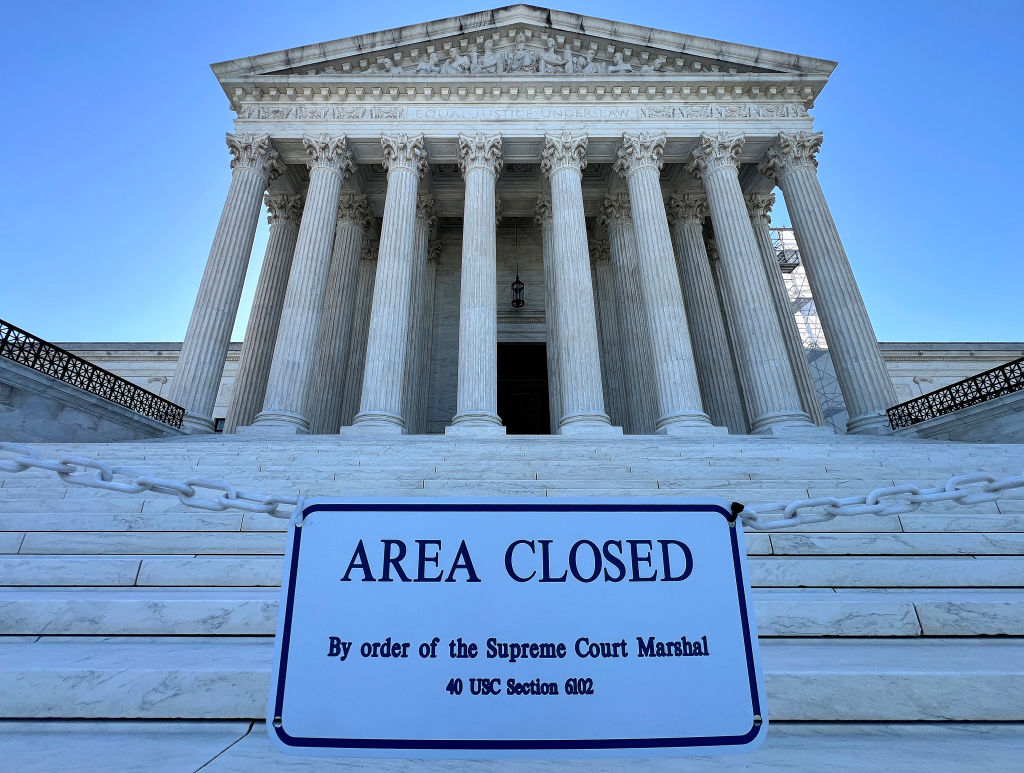
OH—DID YOU THINK WE FORGOT ABOUT JANUARY 6?
In addition to the aforementioned nail-biters, there are also a few cases that go to the heart of what our democracy even is—and what it might become. They raise questions like:
- Can a former president be prosecuted for, say, trying to overturn the results of a democratic election? Or can he be charged for obstructing the certification of those results? We’ll discover those answers in the cases of Trump v. United States and Fischer v. U.S.
- Can a presidential administration ask social media companies to stop spreading misinformation about, say, unprecedented health crises? You'd think this is a gimme, but the Republican Attorneys General who filed Murthy v. Missouri say no!
- SCOTUS will also need to answer the existential question of whether or not the federal government should do, like, anything? Some people (Relentless, Inc. v. Dept. of Commerce, Loper Bright Enterprises v. Raimondo) are wondering.
If all of this happens to rile you up, there are steps you can take that don't involve magically animorphing into President Biden and pushing Congress to expand the courts. (But wouldn't it be nice?)
- Demand Justice, which recently projected an upside-down flag on the Supreme Court building in a sly protest of Alito's (wife's) (allegedly) own upside-down flag, has a number of ways to get involved with their movement, including donating and joining their rapid response team.
- If you happen to be an attorney or law student—or even if you don't—you can join the Peoples' Parity Project, which has many chapters at colleges and in cities across the country. (You can also donate or pick up some pretty cool merch.)
- Fix the Court could use your donation, too, for their big ideas and a roster of several, small but mighty ways SCOTUS could become, in Peoples' Parity Project's words, "unfucked."
See you out there. 🌞
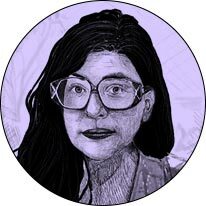
Julianne Escobedo Shepherd is a writer, culture critic, and editor in NYC. Her first book, Vaquera, about growing up in Wyoming and the myth of the American West, is forthcoming for Penguin.
“What We Do in the Streets Is a Way of Grieving”
On the fourth anniversary of the Black Lives Matter uprisings, author Prentis Hemphill offers a new way of looking at things, and what's next.
BY REBECCA CARROLL
Four years after George Floyd’s murder, I realized that I simply do not have it in me to write another piece about Black pain, patterns and cycles of violent racism, and the endless trauma that continues to course through our bodies and bloodlines. I’ve literally written hundreds of them. I’m tired. And it feels like nothing ever changes.
But years ago, I asked the late civil rights activist Julian Bond how he managed to stay hopeful in the face of what often feels like little progress. He said, “There are enough victories to keep hope alive, and that’s what activism is.” And so I keep looking for the victories, which lately has meant having conversations with folks, particularly younger folks, who are deep in the work with fresh eyes, bright minds, and open hearts. Prentis Hemphill is one of those folks, one who, right on time, has a new book out called What it Takes to Heal: How Transforming Ourselves Can Change the World. The author, therapist, and organizer spoke with me about the power of collective grief, finding the small openings of possibility, and the necessity of visual longing.
Rebecca Carroll: Your book begins, “When Trayvon Martin was killed, I had just started working at a community mental health clinic in Los Angeles, one of three Black therapists on a staff of nearly fifty.” How do you hold the grace to write about the fact of yet another Black body being killed?
Prentis Hemphill: The only way is by being in community that can feel, and grieve, and strategize, and celebrate. That’s the only thing that actually sustains me. I can only face things because I’m held, and because I’m also holding. Every time someone in our community is killed in this way, it reverberates. We have memories of people in our communities that were killed that way, people in our families that were killed that way. The ongoing violence against Black people, it reverberates through all of our grief and all of our pain. Even though we as a people have made it this far because we reach for each other, I think we also try to—and have to—shoulder more than is ours to bear.
I was just having a conversation with a dear friend and organizer, Malkia Devich-Cyril, about how our grief has been criminalized and that part of what we do in the streets is a way of grieving. But because of what is projected onto us as Black people, our actions are never read as grief rituals; they are often labeled as violent, disruptive, inconvenient.
By “what we do in the streets,” I take that to mean being collectively loud, actively creating movement culture, and just being Black—does it matter whether we know that we are simultaneously grieving?

That’s a great question. Having been at a lot of protests and on the ground in so many different places over the last 15 years, I think a lot of people know that their grief is present. But there’s the connective piece—the collectivizing of the experience of “I feel this pain”—that we don’t talk about. We know it’s our grief, but we also narrow it, because that’s what we’ve had to do to get by. I am interested in starting to unlock how [our grief] can be bigger, because that’s the truth of what we’re holding.
You wrote about not being able to know how Harriet Tubman learned to trust her dreams. How did you learn to trust your dreams?
I always felt entitled to my life, to an authentic life. I always felt like, if God made me, then I’m all right. I can see the way that human beings create rankings and structures to take you away from the truth of it all, but there was always something in me that wasn’t confused. I would like to say I was just born with that, but I can feel my grandmother in it, I can feel my great-grandmother in it—[this notion] that the world is telling one story, and I feel something truer. I think it means a lonely path for a lot of people who refuse to dim their light. Sometimes, we have to dim our lights for the sake of safety, but for the most part, I cultivate that light in me. I think life wants to express itself.
There’s this one really striking line from the book: “It’s hard to heal when you're still being hurt.” How do we lead our way through healing while we’re still being hurt in all ways?
When we get hurt or experience trauma, when we don’t have space to process it, some part of us gets locked in that moment, and we’re replaying and responding to it all the time. When I work with people, [what makes a difference is] the recognition that in each moment, there is a choice. It may not be an ideal choice, but when our stories hold us captive, we’re no longer able to perceive the choices in this moment. It’s the work of finding the very small openings where something else might be possible. That’s a part of healing. That’s what Harriet Tubman was able to do. She was like, “You have me in this world, but now, I can see that there’s a little opening here. I can see a friend here. I can see a path here.”
It feels like we’re talking about trauma on a national level in ways that we haven’t before—what do you think is on the other side of that conversation?
I’m curious about trauma as a human phenomenon—and knowing this, how then do we structure our societies, our communities? What would we do if we knew that healing was important? I bet we would construct the world in a different way, and it wouldn’t be based as much on exploitative and violent tendencies which we’ve normalized at this point. I’d rather we normalize something else.
In the book, you wrote that visions are rooted in longing—can you say more about that?
I’m not a real churchy person, but “faith without works is dead” is something my grandmother would say all the time. We get sold visions for our lives, sold visions for who we are supposed to be. It’s necessary for us to reactivate that kind of looking around that, again, Harriet Tubman was able to do—looking through the cracks, looking underneath, and activating our own strangeness. No matter what happens tomorrow, we are facing compounding, complex crises. I hope that [my book] is a tool, something that accompanies people through the changes and challenges I think we're all facing.
My name is Prentis, which means student. I feel like my role is to tenderly offer the questions that I feel need to be posed in this moment. I don’t position myself as an authority. I position myself as someone who is learning, someone whose role in community is to pose questions—and to keep us close as we try to answer them.
"They Don't Look at Us as Human Beings"
Lead plaintiff Amanda Zurawski on the Texas Supreme Court’s decision to uphold a ban that almost killed her—and why she’s planning to run for office herself
BY CINDI LEIVE
We’ve grown accustomed to courts acting coldly, but last Friday’s Texas Supreme Court decision seemed especially and brutally devoid of compassion. In Zurawski v. State of Texas, the court had heard from 20 women who had been denied abortion care when experiencing pregnancy complications—women who had hemorrhaged, been forced to carry babies without skulls, and nearly died. And yet, the justices still ruled not to change or amend Texas’s abortion ban, which has forced doctors to deny patients vital medical care out of fear of prosecution. (What this says about the state’s regard for the vastly greater number of people who need abortions for less “medically necessary” reasons—such as, you know, not wanting to be pregnant anymore—is a story for another time.)
Over the weekend, I called Amanda Zurawski, the woman who lent her name—and the last year and a half of her life—to the lawsuit. I first met Amanda in the fall of 2022 when a doctor whispered to one of my Meteor colleagues that there was a woman in Austin who’d been through hell and might be willing to share her story. She did, detailing her harrowing experience for the world, but then went on to do much more, testifying before Congress, speaking up for other patients—and taking on her own state’s government.
Cindi Leive: This decision felt like a punch in the face to so many women—but for those of you who testified, and your families, it was so personal. What measure of justice were you and [your husband] Josh expecting? How much was this a surprise to you?
Amanda Zurawski: It wasn't a huge surprise because we know that the Texas Supreme Court is full of conservative Republicans—[all] nine of [the justices] are conservative Republicans. And then, after the ruling in the Kate Cox case [in which the court denied the December 2023 abortion request of a Texas woman whose fetus had no chance of survival], that was a signal of how our case was going to go. So we had time to prepare for a loss.
What we weren't expecting, and what we were really surprised by, was the way that they wrote the decision—that they literally wrote out most of the plaintiffs by not even using their name. [Only three patients and two doctors were referred to by name in the ruling.] And that felt unnecessarily cruel and offensive…To me, it means they don't care about us and they don't look at us as human beings. They don't care about our trauma, our grief, our loss. They don't want to acknowledge us. Because as long as they can ignore us and pretend like we don't exist—just like my Senators [Ted Cruz and John Cornyn] did when I testified in front of Congress—they can pretend like the problem isn't real.
We did a press call right after the ruling came out, and there were 11 plaintiffs that could join. And seeing their faces and hearing their voices and how heartbroken they were—that was really gutting.
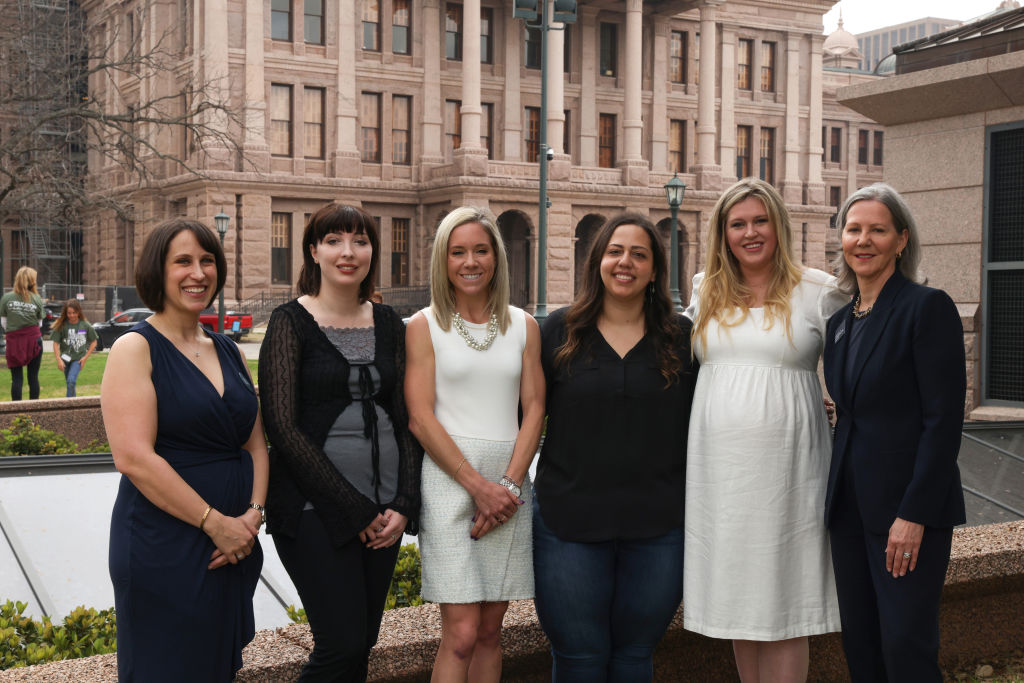
You said that that was the hardest part for you. Why?
I want to acknowledge my name was used in the Supreme Court's decision. They did acknowledge what happened to me personally, and they didn't for anyone else. And that feels very unfair and very unjust. And I also feel a little bit like…people were counting on me, I think, because I was the first one to file, because it was my name on the suit…I do feel a little bit like people were depending on me, and I feel a little bit like I let them down.
You said on Friday, “We will continue to fight.” Tell me how.
Well, I don't think our lawsuit can do much more. People keep asking me if it's going to go to the U.S. Supreme Court, and I want to make it very clear that…likely, this is the end. But we can keep fighting in other ways. Personally, I will continue to campaign to get people to vote for pro-choice candidates. We can continue to share our own stories and to share other people's stories. We can donate our time and our money to abortion providers and organizations.
And did you say that some of the Texas Supreme Court justices are up for reelection?
Yes! There are three up for reelection [Jimmy Blacklock, John Devine, and Jane Bland]. I think we know now very clearly how they feel about…a woman's right to choose, so I'm really hoping that we can get the word out before November and not get them reelected. It feels really good to be able to say that so clearly, because for a year and a half I couldn't, because we had an ongoing lawsuit. [Now] I'm like, let's light some fires.
I’ve been thinking about what’s happened in Texas since you first filed your lawsuit. You were the first [plaintiff], and then there were five women, and then 20. And I don't know if you saw this thread, but just two weeks ago, Ryan Hamilton, a musician and DJ, tweeted that his wife, who had been pregnant with their second child, was denied abortion care in a very similar situation to yours. Despite the baby no longer having a heartbeat, she was repeatedly sent home. She lost so much blood that he found her unconscious on the bathroom floor. She almost died. This happened in Texas two weeks ago. How does it feel knowing that while the Supreme Court is making this decision, claiming that doctors are able to do the right thing [under existing Texas law], the number of women who have been exactly where you were continues to climb?
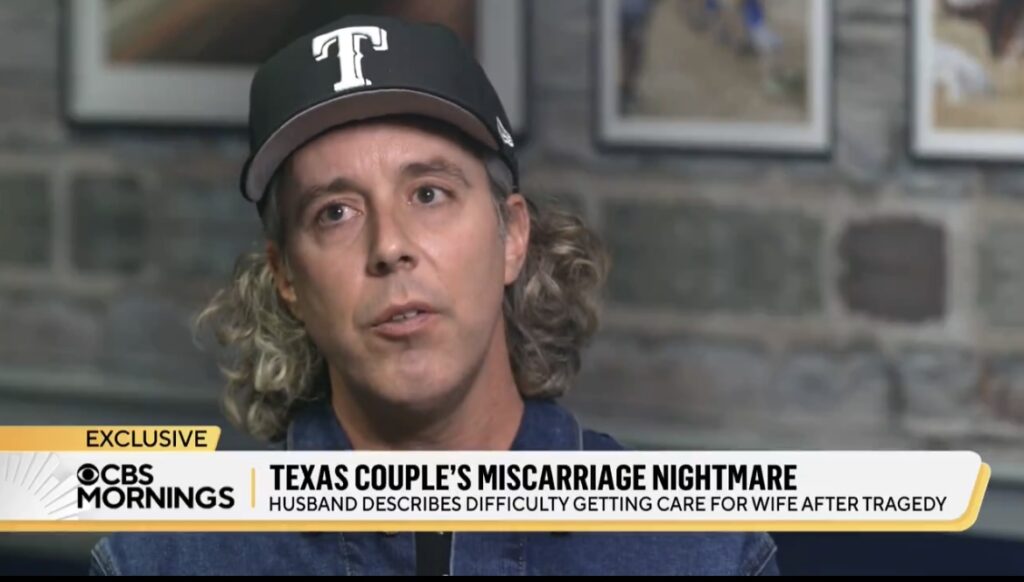
That story makes me sick to my stomach. And it's going to keep happening, because lawmakers aren't doing anything to fix it. It's infuriating that the Supreme Court of Texas had the opportunity to fix this—had the opportunity to make things better—and they did nothing. And when the Supreme Court says, “Doctors can practice medicine, this isn't a problem, the law is clear”—clearly that's not the case! Listen to our stories. Listen to what's happening to us. Listen to doctors. They refuse to hear us, and I don't know what it's going to take for them to wake up and realize that people are dying because of this. Or if they haven't yet, they're going to.
There's an enormous amount of suffering happening in Texas and similar states, and they need to fix it.
Three months ago, when the Alabama Supreme Court was deeming embryos people, you said that you worried that Texas was going to do the same, and that you were going to move your embryos out of state. The irony is incredible: You need IVF because the state's laws impacted your fertility, and now the state is making that path to having a family more difficult. How has that process felt?
It was pretty upsetting, because moving embryos is, as you can imagine, incredibly complicated. It is very expensive. And from my understanding, things don't go wrong very often, but if they do, it's catastrophic—you lose your embryos. As we [were] going through it, I'm like, this is terrifying, because I feel like we're on a ticking clock, because Texas [could] make this decision [to criminalize IVF] any day. By the way, there now is a case about embryonic personhood that the Texas Supreme Court is deciding whether or not to hear…[and] depending on how they rule, it could do the exact same thing that happened in Alabama and threaten IVF access. Fortunately, our [embryos] are now safe, but if Trump is reelected, we're scared that it won't matter where your embryos are, because he'll institute national bans or laws that are going to affect their safety. It's just a really troubling, scary time right now to be trying to plan a family.
Last question—what gives you hope right now? Is there anything?
You know, in our press call, my fellow plaintiff, Dr. Austin Dennard, said that she likes to think that people are good. And I agree with her. I think that most people at their core want to do the right thing. And when we're speaking out about what happened to us, we do see a lot of goodness in most people. And I see the people who are fighting in their communities. I see people who are running for office because they're trying to protect women. And I think there's a lot to be hopeful about. I do think we're going to fix this. It's going to take a lot of work, but we can do it.
You mentioned women running for office. I can't get off the phone without asking you the same question that America Ferrera asked you onstage at our event a year and a half ago. Any further thoughts about you running for office?
Oh, yeah… That is probably going to happen. I've started trying to figure out what office might be a good fit for me. I’ve talked to a lot of different organizations; I’ve talked to a lot of different individuals. I think the next step would be fundraising. But Zurawski ‘26 is probably something you’ll see.
Zurawski 2026. Amazing. We’ll leave it there.
The plaintiffs in the case are: Patients Amanda Zurawski, Lauren Miller, Lauren Hall, Anna Zargarian, Ashley Brandt, Kylie Beaton, Jessica Bernardo, Samantha Casiano, Austin Dennard, D.O., Taylor Edwards, Kiersten Hogan, Lauren Van Vleet, Elizabeth Weller, Kristen Anaya, Kaitlyn Kash, D. Aylen, Kimberly Manzano, Danielle Mathisen, M.D., Cristina Nuñez, and Amy Coronado; and health care providers Damla Karsan, M.D. and Judy Levison, M.D., M.P.H. Read their stories on Center for Reproductive Rights' site.
The Threat of Ozempic "Coercion"
The drugs are everywhere. Oprah takes them; I’ve taken them. But activist Virgie Tovar says that in a fatphobic culture, there’s no such thing as a truly free choice.
By Samhita Mukhopadhyay
Over the last few years, weight-loss drugs—a category that includes semaglutides like Ozempic and Wegovy and the tirzepatide Mounjaro—have surged in popularity; so have conversations about them. Oprah, who is taking a semaglutide, just hosted a special on her evolving feelings about weight loss; body-positive influencers who have decided to go on these drugs are being asked why. I have written about my own experiences both taking and later coming off Mounjaro, including my concerns about what taking a “diet drug” might mean for my longtime commitment to size inclusivity.
I wasn't sure there were many more new thoughts around this issue. But a recent conversation with Virgie Tovar, the longtime fat activist and the author of You Have the Right to Remain Fat, made me think differently. Tovar has been vocal about her feelings about Ozempic and what it means for the lived reality of fat people. I asked her to talk to me about it all.
Samhita Mukhopadhyay: I’ve been dying to have this conversation with you, Virgie. You’ve written about fat politics and done groundbreaking work in the fat inclusion space for decades. What are your thoughts on Ozempic?
Virgie Tovar: The question for me is: What does going on Ozempic look like in a culture where there's so much fatphobia? I've always wanted women to be able to choose whatever is going to help them thrive within the culture we live in. For me, it's been fat activism; it's been being anti-diet, it's been being fat. These are the things that have helped me thrive. I've never been happier, I've never been more connected, and I've never felt more successful. I want a world in which people can choose to do whatever is going to help them [while] understanding that there is no truly full autonomy to choose. I think about the arguments that feminists were having in the eighties around what consent even means in a culture [of] misogyny. That question haunts our culture in all these different ways.
How do you address the question that everyone brings up when anyone talks about fat acceptance: “What about your health?” Oprah just did another special on weight loss—this time, taking on diet culture. And it wasn’t terrible! But she still said that “obesity is a disease.” What do you think about that?

One of the things that's really important to understand is that the American Medical Association’s decision to classify obesity as a disease [in 2013] was a political decision. It wasn't a data-driven decision. There was a committee that was assigned to do a literature review and to make a call based on the review—and their call was [obesity] does not qualify as a disease. [The AMA moved forward with the decision despite the committee’s recommendation.] This is one of those itty-bitty moments in medical history that gets completely buried. The only headline was obesity disease, obesity disease.
The AMA decision, inadvertently or not, created a pathway for physicians to step in and become the face and the leadership of diet culture. And now we're looking at prescriptions. Now we're looking at medication; now we're looking at pathology. We're not [just] talking about beauty and whether or not you can wear a bikini in summer; we're talking about diabetes. Which is [a significant] shift because an unregulated non-physician-run diet industry doesn't get the [same] traction that a lab-coat-wearing person talking about illness [does].
What I find so fascinating about this whole conversation is that fatphobia and weight-loss preoccupation are so central they create a reality in which all outcomes end [with weight loss]. And there's another universe in which when people have a health concern, instead they think, Why don't we have universal healthcare? There's a world in which we look outward, and we demand—with the same fervor that we're searching for Ozempic—that we change the policy and that every single person has universal healthcare. There’s a world in which when people start to have [health issues], they think, why are we working so hard? But that’s not what we do.
What amazes me is there are a million potential health interventions available to human beings, but no one sees any of those. [Weight loss] is the only solution we're comfortable with.
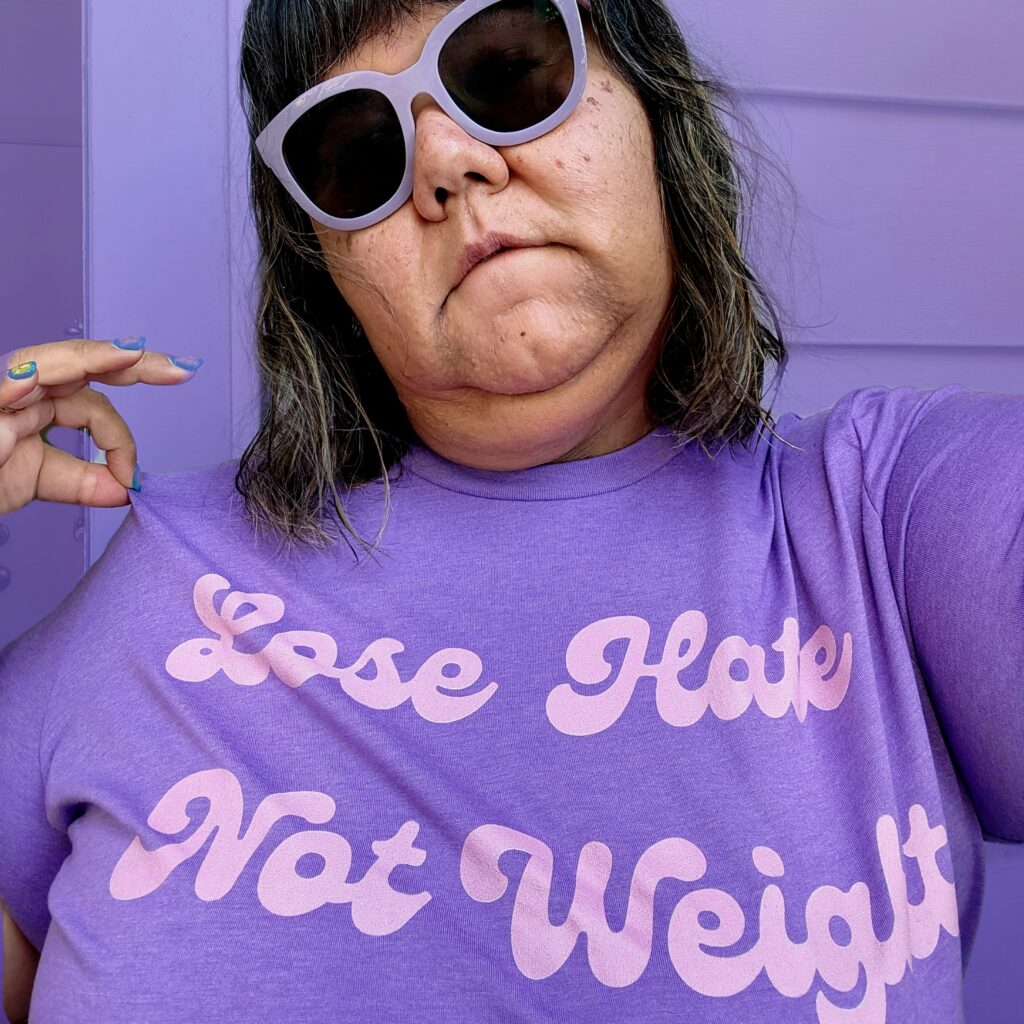
And what is your response to people who reiterate the research about obesity and life expectancy?
The culture is obsessed with one piece of data, which is that fat people live shorter and less healthy lives than thin people. And what's scary to me is that one piece of data gives pharmaceutical companies and doctors this cavalier attitude. It creates an extremely terrifying, morally hazardous reality in which whatever happens to us [as we try to lose weight] is just collateral damage; it's all learnings on the way to the solution [of weight loss] that they truly believe is just around the corner. When weight science is very clear that it's not. Unless we're talking about literally genetically altering zygotes, unless we're talking about eugenics, there isn't a reality in which there aren't going to be bigger people and smaller people.
There is no single data point that tells an entire story. When you look at the multiple data points [around weight and health], they tell you a [more] clear story. So, the first additional data point I want to bring up is that all marginalized groups live shorter or worse lives than people who are in a dominant group. Black Americans still live shorter lives than white Americans, and people in the LGBTQ community have worse health outcomes than people in the straight community. So, right now, weight discrimination is legal federally. When we accept what minority stress theory teaches us—which is that all marginalized groups have worse health outcomes—that starts to fill out the story.
We have this idea that without diet culture, Americans would just eat nonstop and become bigger and bigger—but that’s a lack of understanding of basic data: Dieting makes us binge-eat and increases our weight over time.
[With other issues], we don't use the framework of “We have to change that person” in order to fix it. We understand that there are societal problems that need to be solved in order for people to have a better quality of life and longer life expectancy. It is only our fat phobia that disallows us from using the frame that we use to understand every other civil rights issue.
Then the second data point is that even though our culture thinks that weight loss is awesome and healthy, weight science is very, very, very clear—the body and the nervous system may experience weight loss as extremely distressing. The third data point is that we know that people who are in larger bodies who don't have high internalized fatphobia have [better] health outcomes [than] people in the same larger bodies who do. They don't have the same [reduced] longevity outcomes as people who do internalize fat phobia.
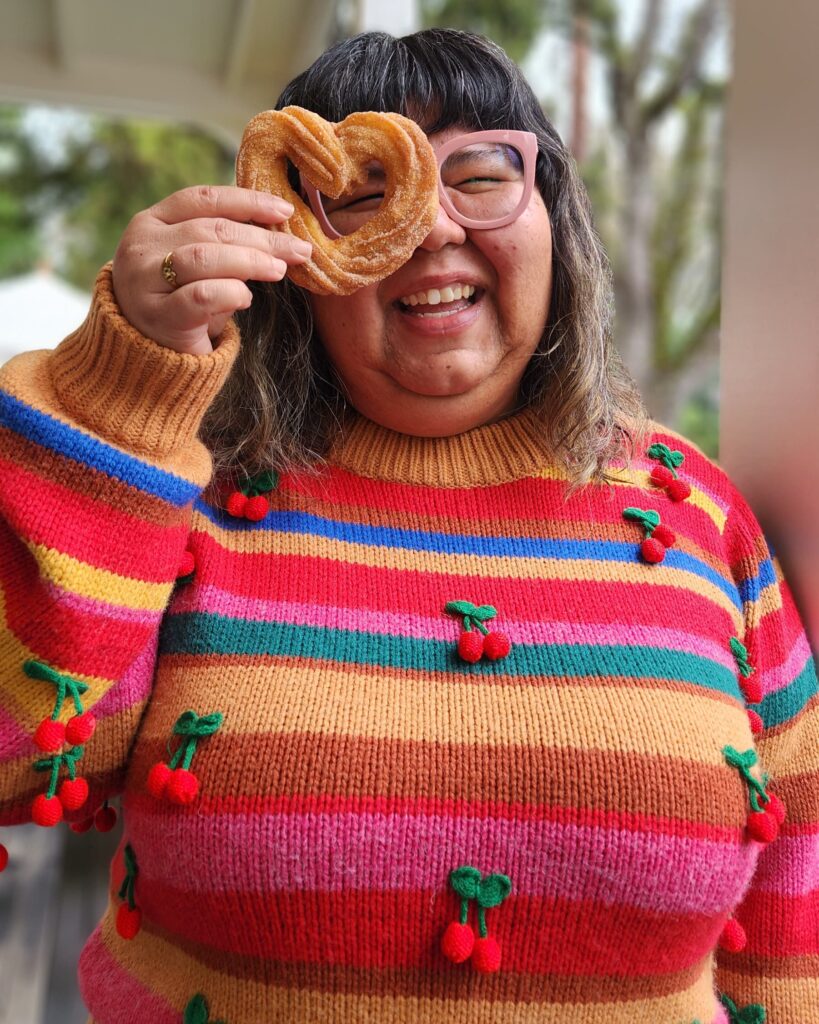
So, what do weight-loss drugs mean in the context of all this?
We try to create environments of neutrality where people can make the right decision around serious medications but that is not the environment we are in [around weight loss]. I've been using the word coercive to describe it.
Can you expand on what you mean by “coercive”?
Number one: we live in a culture that hates fat people. I think that's changing, but people really still believe that the worst thing you could be is fat. So imagine making a decision about whether or not you're going to take a medication that has pretty intense side effects, and that is very costly in the context of If you take this, you will [no longer] be part of a group of people who are reviled or discriminated against.
I can imagine it.
Now that we're understanding it's wrong to promote weight stigma, the thing that feels like it's in the air—that continues to be the dog whistle—is like, But health! You can convince yourself that nobody should be pressured to look a certain way. And that's easy to get behind because we all kind of know that's wrong. But what they're doing is this brilliant rhetorical pivot. How could you argue health?
When the path to that “health” (i.e., diet culture) is not always very…healthy.
Yeah. The other part of the story that people have a hard time understanding is a lot of the health outcomes that higher-weight people have are also correlated with chronic dieting and chronic food restriction. We have this phenomenon where [after dieting] your body is now armed and ready for when you do this again. And the way that it's doing that is by increasing your baseline weight. We have this idea that without diet culture, Americans would just eat nonstop and become bigger and bigger—but that's a lack of understanding of basic data: Dieting makes us binge-eat and increases our weight over time.
There’s also been a pretty robust conversation about body-positive influencers taking these drugs. It was reported in The Washington Post that one of these drug companies had reached out to you to see if you’d be interested in going on a GLP-1. Why do you think they are going after influencers?
Plus-size women [authoring] their own stories changed the culture; people didn't know that they could opt out of dieting until body positivity came around. And now that the genie’s out of the bottle, it would take an incredible reversal—which I think, frankly, some of these pharmaceutical companies are trying to do. They see it, right? Why in the world are you targeting body-positive influencers if we're not a threat?
So, after reading everything I've written about my own journey about going on and off Mounjaro, and especially making the decision to take the drug after my father died from diabetes-related complications—what advice would you have given me throughout this?
The very first thing I would've told you is grieve. Don't let the note that stays in your mouth about the passing of your father be that of phobia.
And then I would say, let's talk about what being on this medication might look like, and let’s allow time to process—read, read it again, have questions about it. I guess for me, for people making decisions, the timeline would be longer. I think there would be serious conversations about what's really at stake here. And I think in my ideal world, I'm saying to this person, you have the right to take this medication. No one can take that away from you. But don't let fatphobia be the thing that pushes you from a no to a yes.
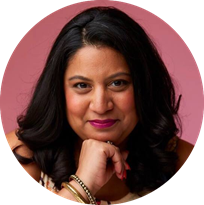 Samhita Mukhopadhyay is the Editorial Director of The Meteor. She is the author of the forthcoming book, The Myth of Making It. She is the former Executive Editor of Teen Vogue and is the co-editor of Nasty Women: Feminism, Resistance and Revolution in Trump's America and the author of Outdated: Why Dating is Ruining Your Love Life.
Samhita Mukhopadhyay is the Editorial Director of The Meteor. She is the author of the forthcoming book, The Myth of Making It. She is the former Executive Editor of Teen Vogue and is the co-editor of Nasty Women: Feminism, Resistance and Revolution in Trump's America and the author of Outdated: Why Dating is Ruining Your Love Life.
Everyone is Having Fun Talking About Drake and Kendrick Lamar
A long-time music critic tackles a darker truth at the core of their beef: the expendability of women’s trauma
By Julianne Escobedo Shepherd
Kendrick Lamar and Drake have spent the better part of the past month in a rap beef, which you might already know if you spend time on social media, where they've been trending for days. The origin of their acrimony is vague—the former collaborators turned on each other around 2013—but this recent round was kicked off in late March with a song called "Like That" from Future and Metro Boomin's latest album, We Don't Trust You, on which Kendrick, guest-rapping, essentially called Drake a poseur and a chicken. That provoked some peripheral fallout, including a Drake diss by Rick Ross coming from the sidelines and a very weak response track by J. Cole, which he later walked back, apologizing to a stadium full of his own fans.
Confused? There is a lot of minutiae here and even more menergy; all of this feels like a desperate display of testosterone in an era when women rappers are finally flourishing. But there are larger issues here that go beyond which rapper has the better flow, and it might not surprise you that women have ended up as collateral damage.
Rap beef is rooted in the Dozens, a traditionally African American game of insults. The Dozens, in turn, influenced the freestyle battles that have flourished since hip-hop's inception, in which two rappers diss each other to flex their superior lyrical talents, not unlike a verbal boxing match. In the Drake versus Kendrick battle, Kendrick is obviously superior; he has a better grasp of the language overall—a skill for which he once won a Pulitzer—and is more capable of varying his writing style. There is a comfortable consensus, too, that he's winning the battle due to how deeply his insults cut, to the point that I keep imagining him as the X-Men character Psylocke, wielding a particularly sharpened psychic knife.

But as far as rap beefs go, this one feels increasingly gnarly. When Kendrick first asserted on "Like That" that respect is better than money or power, implying that Drake had the latter but not the former, it was fairly standard fare. Drake responded with "Push Ups," which dissed Kendrick's star power, and also with "Taylor Made Freestyle," which claimed that Kendrick's releases were being controlled by Taylor Swift. The idea that a man is in servitude to a woman is a pretty standard insult—but in retrospect, it was also an indicator of where this was all going.
Over the course of four more Kendrick songs and two more Drake songs, all released in the short span of seven days, the rappers hit one another with an escalating series of basically criminal accusations. (On Monday evening, a security guard outside Drake's Toronto mansion was shot, though authorities are currently investigating.) Drake accused Kendrick of hiring "a crisis management team to clean up the fact that you beat up your queen." My stomach fell upon hearing it—it's a shocking accusation, especially when it’s brought up so lightly in a rhyme.
But even worse was the fact that Kendrick's response was released only 30 minutes later, and so the accusation of violence barely seemed to register. Besides, Kendrick's barbs were just as nasty: that Drake is a pedophile, has a sick interest in underage girls, and that his record label might, in fact, be a ring of pedophiles. Kendrick suggested that Drake should be locked up alongside Harvey Weinstein, who at this moment is awaiting a new trial after a New York court overturned his rape conviction. Obviously, rapping it doesn’t make it true: As a written art form, a lot of rap lyrics are fantasy or narrative construction—that's part of why it's an infringement of First Amendment rights when those lyrics are used as evidence in trials. But does assuming that these allegations are simply lyrical shivs make them any better? Actually, the idea that women and girls are simply pawns in a brawl implies that neither artist cares too much about their well-being—unless they can be used as a weapon.

And if these accusations have even a kernel of truth to them, they reflect the way the entertainment industry keeps secrets to protect its own (and the way the #MeToo movement barely touched the music industry.) I keep thinking about Megan Thee Stallion, one of the most talented rappers in the U.S., who spent two full years being excoriated by male musicians and internet trolls after she accused Tory Lanez of shooting her in the foot; she was in a desperate enough place that she later rapped about her thoughts of suicide. Before Lanez was convicted in December 2022, even 50 Cent was forced to apologize for his ill-treatment of Megan.
But throughout the case, Drake was one of the worst offenders against Megan, rapping, "This bitch lie 'bout gettin' shots but she still a stallion," one line in a trilogy of Drake albums that seemed to trace his further descent in the darkest crevices of misogyny. (His latest, For All the Dogs, seems at times to just be a list of grievances against women.) As Vulture's Craig Jenkins wrote in a wide-ranging piece about the violence and sex trafficking allegations against superproducer Diddy, "We can’t keep picking and choosing whose abuse we’re willing to buy, turning support for survivors into a contest of whose abusers made the most beloved songs. We can’t let wealthy men treat everyone in the vicinity like chattel."
Megan eventually was able to bite back—her January 2024 diss track "Hiss," which in part takes aim at Drake, is the most listenable of all the songs in this rap beef—but the scars are right there on her album, called Traumazine. The unnamed women in Drake and Kendrick Lamar's beef tracks surely have their own scars, too. While hip-hop battles can sometimes feel like a sport, this one has become increasingly nihilistic. One wonders if either of these men is invested in what they’re saying or can even fathom what’s at stake for the lives of the people they are talking about, real or fictional.
“I Did Not Think This Change Would Come in My Lifetime”
A seminary dropout on the latest decision from the United Methodist Church
By Bailey Wayne Hundl
For the last 25 years, pastors in the United Methodist Church (UMC) have faced losing their jobs and having their ordination revoked for officiating same-sex weddings—even when doing so for their own children. The UMC bylaws have also prohibited “self-avowed practicing homosexuals” from being ordained as ministers—or appointed to serve in any capacity—since 1984.
All of that changed on Wednesday. With an overwhelming majority and no debate, the denomination’s highest legislative body voted to overturn these policies.
For me, this is personal. For the better part of a decade, I was one of those pesky “self-avowed practicing homosexuals” causing trouble in the UMC. (That link has my deadname, but I’ll be cool about it if you will.) While I was in seminary, I even sought ordination through the UMC—though admittedly, I didn’t make it very far. And when I think about all the shit I’ve seen, I have to be honest: I did not think this change would come in my lifetime.
When I was 19 years old, I interviewed for an internship with a youth pastor at a UMC church. It went phenomenally (mainly on account of me being awesome and a Capricorn rising). The youth pastor even told me, “I have other people to interview, but if I’m being honest, you’re perfect for this and this is perfect for you.” I said that that was great, but that before we finished, there was one last thing he should know about me; I told him I was gay. And he asked me to leave.
I went home fuming but undeterred, a feeling that, over the years, became all too familiar. When I was 20, I attended a UMC legislative session reviewing the church’s restrictive bylaws against gay people. Before the vote, anyone could come to the mic and speak for or against the issue—and the lines for both were long. I remember the burning of my ears and the tight grip of my friend’s hand in mine as one woman droned on about the dangers of the “demon” of homosexuality and how we must do anything in our power to stop it. In that same room two years later, at a conference for queer Christians, I watched my friend break down in tears as he described being exorcized by his foster parents, who later disowned him.
I carry too much pain from these experiences to expel in one short article. Do I mention my first pastoral internship, the one I accepted before I came out, where I waited for my host family to fall asleep so I could whisper over the phone to my boyfriend that I loved him? The otherwise progressive church who kicked a gender-nonconforming member out of their choir for being “too distracting”? Or hell, what about the responses I received just yesterday when I tweeted in celebration?

For years, I grew more and more battle-hardened, staying in the fight (and the church) for three reasons: my love for the faith, my love for queer people, and the notion that somebody had to clean up this mess. Eventually, I made the choice so many have: I left for my own sanity.
I know that for many people, this seems like the obvious choice. “If the church is homophobic, why don’t you just leave?” But when we buy into the false dichotomy of Religious vs. Queer (a dichotomy invented by homophobes, mind you), we force queer people to sever themselves from a crucial aspect of themselves, something that gives their life meaning, community, and hope. And I’ve watched too many people—people I love, people I miss—pick the former.
But now, thanks to this monumental decision brought about by the stubborn hopefulness of queer Methodists and their allies, fewer of my family will be forced to leave themselves behind. It’s a good day.



